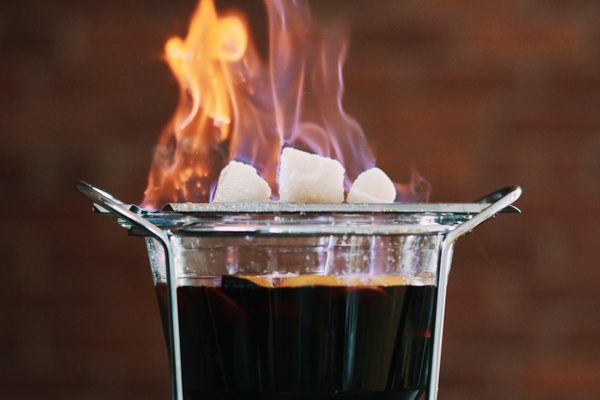This 19th-Century Cocktail Still Fights Cold Nights in the Midwest
The Tom and Jerry is a Christmas staple.
This month, Gastro Obscura is sharing the recipes and stories behind amazing holiday dishes and drinks from around the world in the ongoing series “Home-Cooked Holidays.”
It’s not often one needs to make a batter for a cocktail, but so it is with the Tom and Jerry, a Christmas party staple in the American Midwest. The drink begins with a frothy batter of separately beaten egg whites and yolks folded together and mixed with sugar and warm spices. When served as a party punch, the sweet batter is often ladled out of special Tom and Jerry punch bowls into matching cocktail mugs, along with hot milk (or water), rum (or brandy), and a sprinkle of nutmeg. The result is a delicious, warm revamp of the classic eggnog.
The Tom and Jerry’s origins are frequently traced back to a clever publicity stunt orchestrated by the British journalist Pierce Egan. The story goes that Egan added brandy to eggnog to create a signature cocktail to promote his 1821 book, Life in London, or The Day and Night Scenes of Jerry Hawthorn Esq. and His Elegant Friend Corinthian Tom. A subsequent play based on the book, Tom and Jerry, or Life in London, also produced in 1821, has additionally been associated with the beverage. While this origin story remains unverified, Egan’s work did make a meaningful contribution to the drinking world: the phrase “Tom and Jerrying,” which means indulging in loud, drunken behavior.
No definitive records exist about the drink’s first appearance stateside, but in 1862, the famed New York bartender Jerry Thomas published a recipe for a Tom and Jerry in his book, How to Mix Drinks, Or, The Bon-vivant’s Companion. That recipe calls for an astounding 5 pounds of sugar and 12 eggs with spices and half a glass of Jamaican rum. (Modern variations of the punch exercise more caloric modesty.)
Historians are unclear as to why the Tom and Jerry has become such a Christmas staple in the Midwestern United States, but it was popular enough to merit a cottage industry of Tom and Jerry drink sets, consisting of punch bowls and mugs inscribed with the drink’s name in Old English font. Milk glass Tom and Jerry sets produced by the Hazel-Atlas and Mckee Glass companies were fairly common in the 1940s through 1960s. A New York Times article about the cocktail quotes author Jim Draeger, who wrote a book on Wisconsin’s historical taverns, as surmising that the Tom and Jerry became a Wisconsin staple because the state has an affinity for brandy drinks, and is well-known as a dairy state. Perhaps more than anything, the intense cold of the American Midwest has arguably solidified this warming drink’s staying power in the winter drinking traditions of the region.

Tom and Jerry
Adapted by Gastro Obscura from The Bartender's Guide by Jerry Thomas (1887)
Ingredients
- 6 eggs
- 1/8 teaspoon cream of tartar
- 1/2 ounce Jamaica rum
- ¾ teaspoon of ground cinnamon
- ¼ teaspoon ground cloves
- ¼ teaspoon ground allspice
- ½ cup sugar
- Brandy or rum
- Boiling water or hot milk
- Grated nutmeg, to garnish
Instructions
-
Separate the eggs. Beat the whites with cream of tartar until they form stiff peaks, then beat the yolks until they are, according to Thomas, “thin as water.”
-
Add the spices and rum to the yolks, and continue stirring until incorporated. Fold the egg whites into the yolk mixture.
-
Thicken the mixture with sugar until it has the consistency of a light batter.
- Serve in standard coffee mugs. In each mug, mix two tablespoons of the batter with three tablespoons of brandy or rum. Top off with milk or water, or a combination of the two. Grate fresh nutmeg over the surface and serve.
Notes and Tips
If using a tiny Tom and Jerry mug, use 1.5 tablespoons of batter and 1 tablespoon of liquor.
Gastro Obscura covers the world’s most wondrous food and drink.
Sign up for our regular newsletter.

















Follow us on Twitter to get the latest on the world's hidden wonders.
Like us on Facebook to get the latest on the world's hidden wonders.
Follow us on Twitter Like us on Facebook